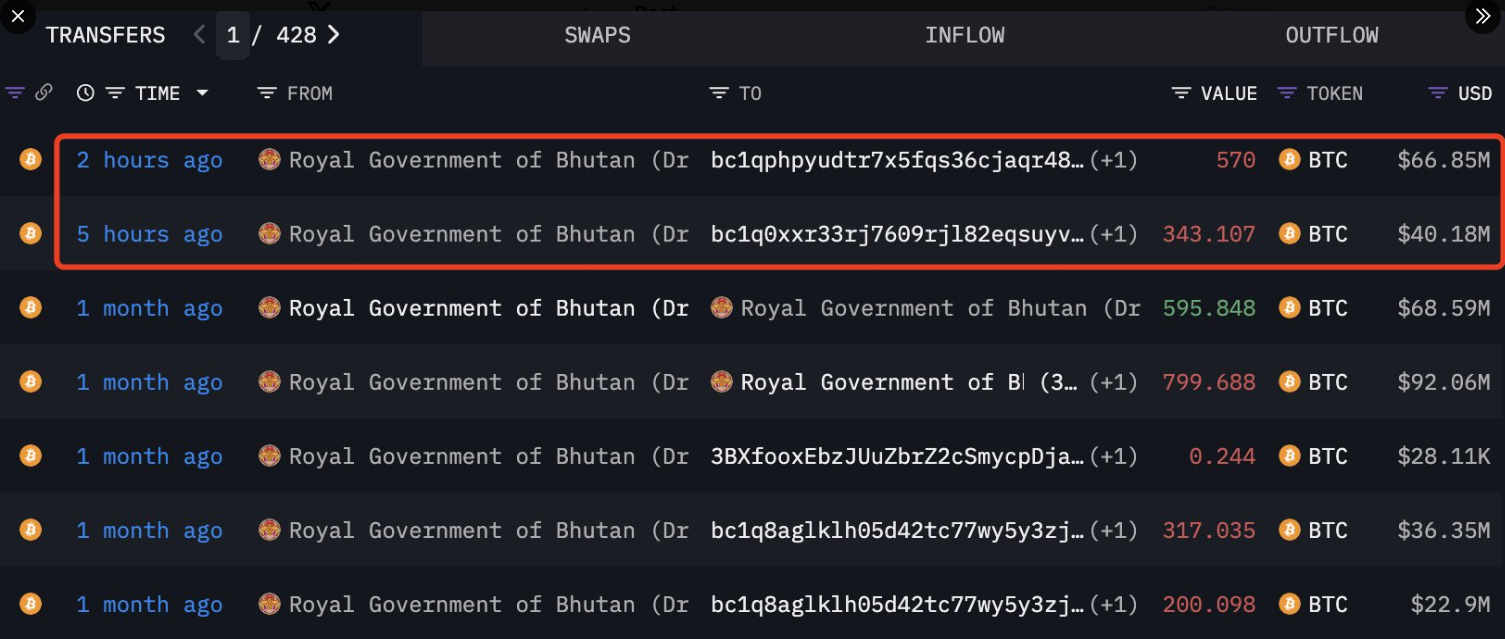Bhutan Bitcoin transfer moved 913 BTC (~$107M) into two new wallets, suggesting a possible partial government sale amid the Fed’s first 2025 rate cut. This shift could add near-term sell pressure while markets absorb rate-driven volatility and on‑chain whale activity.
-
913 BTC moved by Bhutan into two new wallets, worth about $107 million.
-
Original wallet still holds 9,652 BTC (over $1.1 billion), per blockchain analytics reports.
-
Market context: the transfer coincided with the US Fed’s first 2025 rate cut, raising short-term volatility risk.
Bhutan Bitcoin transfer: 913 BTC moved to new wallets, raising sell-pressure concerns after the Fed rate cut — read expert analysis and market implications now.
Analysts are warning of a potential investor “recalibration” for short-term market volatility, which has historically occurred after US interest rate cuts.
The Royal Government of Bhutan transferred more than $100 million worth of Bitcoin this week, raising concerns about potential sell pressure in the market just as the US Federal Reserve delivered its first interest rate cut of 2025.
The Bhutan government-labelled wallet moved 913 Bitcoin (BTC) — roughly $107 million — into two newly created cryptocurrency wallets on Thursday.
The original wallet still holds 9,652 Bitcoin, worth over $1.1 billion, according to blockchain analytics providers reporting on the movement.
The transfers may indicate Bhutan is preparing to sell a portion of its holdings. If the government liquidated its entire stash, it could add more than $1 billion of supply to the market, increasing short-term pressure on prices.

What does the Bhutan Bitcoin transfer mean for markets?
The Bhutan Bitcoin transfer signals a potential policy shift from holding to active portfolio management by the state. Front‑loaded, short-term implications include possible increased supply and volatility; longer term, the move underscores state-level engagement with crypto policy and reserves.
How large were the recent Bhutan transfers and where did the coins move?
On Thursday, the government-labelled address moved 913 BTC into two new addresses. The original address retains 9,652 BTC. Blockchain analytics services reported the activity as the first movement from that wallet in a month, following a $92 million movement on Aug. 18.
Why does timing around the Fed rate cut matter?
Movements coincided with the Federal Open Market Committee (FOMC) delivering the year’s first interest-rate cut. Historically, rate cuts can trigger short-term crypto volatility as investors “sell the news.” Bitget chief analyst Ryan Lee noted crypto often dips 5–8% after cuts before resuming upward momentum.
Whale activity: what else moved this week?
Alongside the Bhutan transfers, an unknown long-dormant whale moved roughly $116 million of Bitcoin acquired over a decade ago. Such large on‑chain movements, especially near major macro events, can amplify price swings as investors interpret intent and liquidity needs.
How might other assets respond?
Analyst commentary suggests Ethereum and Solana could outperform in the near term due to ETF-driven inflows and network catalysts, while Bitcoin may consolidate before resuming a potential rally if further rate cuts materialize.
Comparative snapshot of Bhutan holdings and recent moves
| Metric | Amount | USD Value (approx.) |
|---|---|---|
| Recent transfer | 913 BTC | $107 million |
| Remaining in original wallet | 9,652 BTC | $1.1+ billion |
| Potential total liquidation | ~10,565 BTC | $1.2+ billion |
Frequently Asked Questions
Did Bhutan actually sell Bitcoin or just move it?
Blockchain records confirm on‑chain transfers of 913 BTC into two new addresses, but transfers alone do not prove a sale. Analysts view such movements as preparatory steps that can precede liquidation, though custody transfers for security or treasury rebalancing are also common.
How have markets historically reacted to Fed rate cuts?
Historically, crypto has experienced short-term dips of about 5–8% after US rate cuts before resuming gains, according to market analysts and on‑chain studies. This pattern suggests potential near-term volatility following the Fed announcement.
Key Takeaways
- On‑chain movement: Bhutan moved 913 BTC into two new wallets, signaling possible preparation for sale.
- Scale: The original wallet still holds over 9,600 BTC, meaning full liquidation could exceed $1 billion in supply.
- Market context: The transfers coincided with the Fed’s first 2025 rate cut, raising short-term volatility risk but not changing long-term state adoption trends.
Conclusion
Bhutan’s recent Bitcoin transfers highlight how sovereign crypto reserves can influence market liquidity and sentiment, especially when timed with major macro events like the Fed rate cut. Investors should monitor on‑chain addresses and macro policy signals for short-term volatility while recognizing ongoing state-level adoption. Stay informed for updates and adjust risk exposure accordingly.
Published: 2025-09-19 · Updated: 2025-09-19 · Author/Organization: COINOTAG





